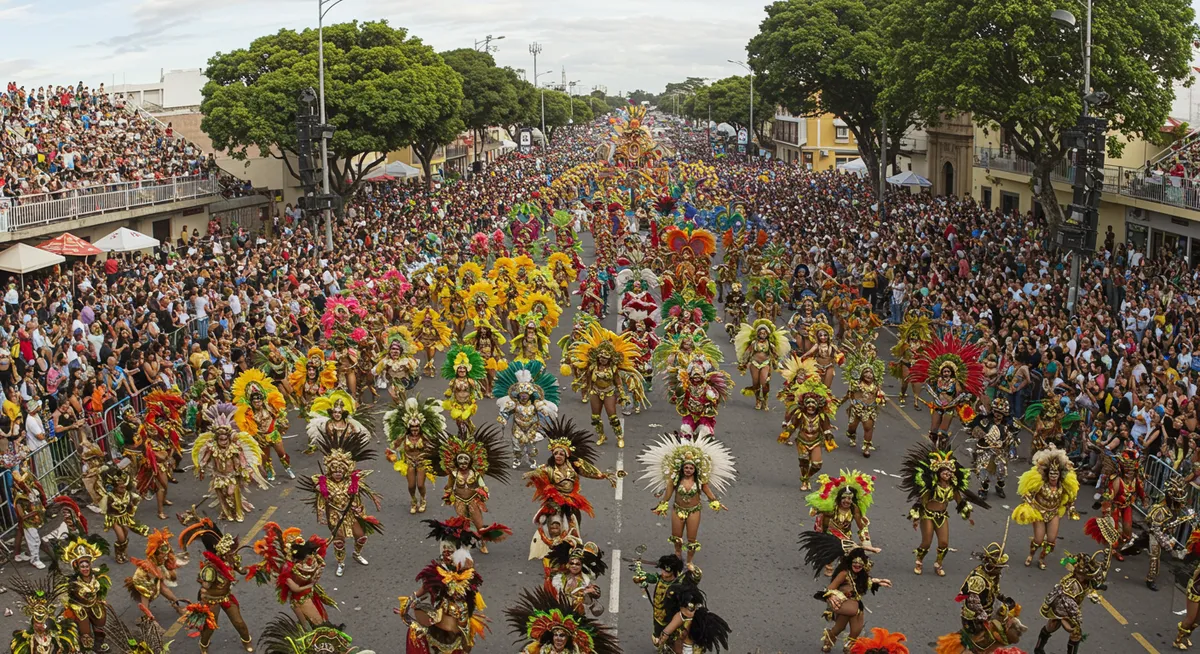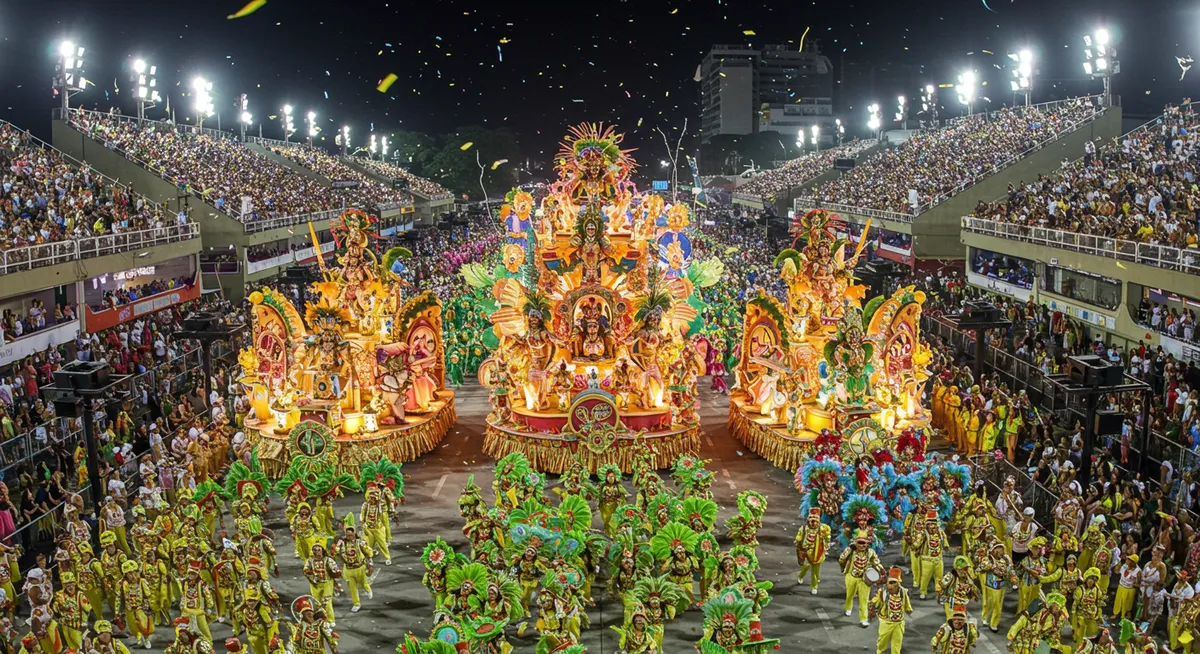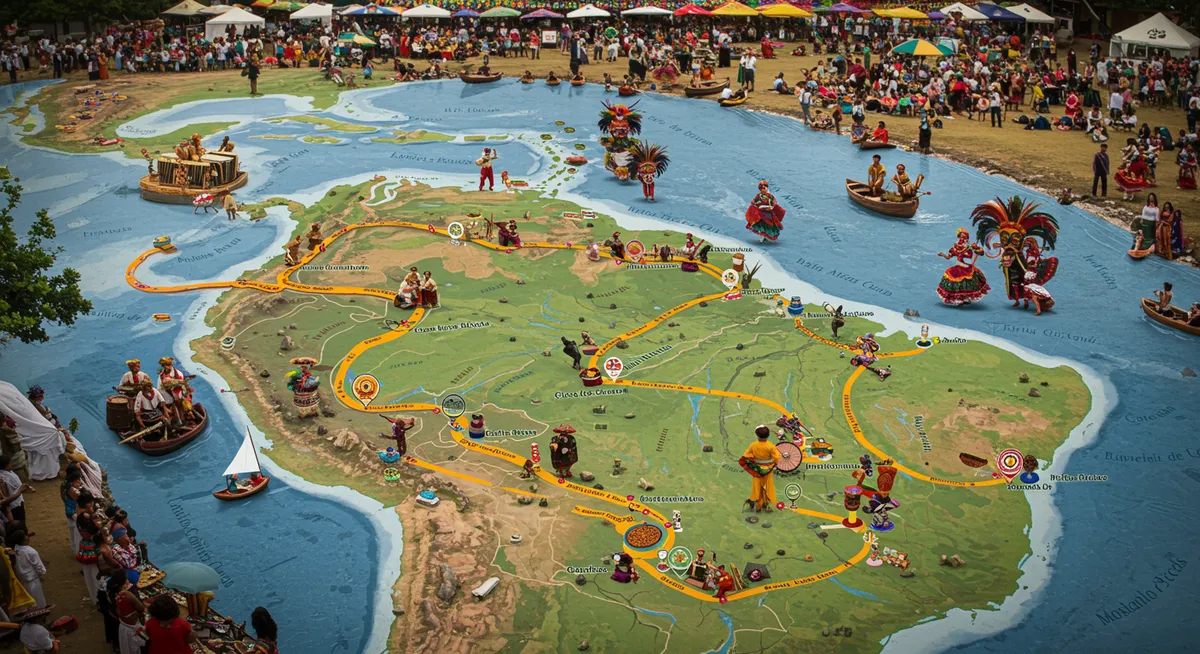Latin American Cultural Festivals Guide | Carnivals & Traditional Celebrations

Latin American Cultural Festivals: Carnival Culture and Sacred Traditions
Latin America's festival landscape explodes with unparalleled vibrancy, where indigenous traditions, European influences, and African heritage blend to create some of the world's most spectacular celebrations. From Rio's legendary Carnival to mystical Andean ceremonies and Day of the Dead rituals, the region offers travelers extraordinary opportunities to experience cultures where music, dance, spirituality, and community celebration reach their most passionate expressions. This guide explores Latin America's most significant cultural festivals across different regions, providing context and practical information for authentic cultural immersion experiences.

The Rich Cultural Foundations of Latin American Festivals
Latin American festivals emerge from a remarkable convergence of influences that have created the region's distinctive cultural identity:
- Indigenous Heritage: Pre-Columbian traditions continue in ceremonies honoring ancient deities, agricultural cycles, and cosmic relationships
- European Colonial Influence: Spanish and Portuguese Catholic traditions brought religious processions, saints' day celebrations, and carnival customs
- African Cultural Contributions: Traditions brought by enslaved Africans introduced distinctive rhythms, dance forms, and spiritual practices
- Syncretic Religious Expressions: The blending of these diverse traditions created unique celebrations found nowhere else in the world
Major Latin American Festival Categories
Latin American festivals can be broadly categorized to help travelers find experiences that match their interests:
Carnival Celebrations
The pre-Lenten carnival tradition reaches its most elaborate and distinctive expressions across Latin America:
- Brazilian Carnival: From Rio's spectacular samba parades to Salvador's street parties and Recife's unique traditions
- Andean Carnival: Bolivia's Oruro Carnival and other highland celebrations blending indigenous and Catholic elements
- Caribbean Carnival: Trinidad's calypso celebrations and distinctive island interpretations across the region
- Colombian Carnival: Barranquilla's distinctive celebration with its unique characters and African-influenced traditions

Religious and Spiritual Celebrations
Catholic traditions blend with indigenous spirituality to create distinctive sacred celebrations:
- Holy Week Processions: From Guatemala's elaborate alfombras (carpet) traditions to Seville-influenced processions in Colombia and Peru
- Day of the Dead: Mexico's Día de los Muertos and similar celebrations honoring ancestors across the region
- Virgin and Saint Festivals: Passionate devotion to the Virgin of Guadalupe, Copacabana, and countless local patron saints
- Indigenous Spiritual Ceremonies: From Maya and Aztec traditions to Andean Pachamama rituals and Amazonian ceremonies
Regional Folk Festivals
Distinctive local cultural traditions are preserved through vibrant festival expressions:
- Gaucho Festivals: Argentina and Uruguay's celebrations of cowboy traditions and horsemanship
- Patagonian Sheepshearing Festivals: Cultural celebrations marking this crucial annual event
- Amazon River Celebrations: Boto (river dolphin) festivals and fishing traditions of riverine communities
- Pacific Coastal Festivals: Celebrations of maritime traditions from Chile to Mexico
Contemporary Cultural Festivals
Modern Latin America has developed vibrant new festival traditions celebrating contemporary expressions:
- Music Festivals: From Colombia's Barranquijazz to Argentina's Cosquin Folk Festival
- Film Celebrations: Major events in Havana, Rio de Janeiro, Cartagena, and Guadalajara showcase Latin cinema
- Literary Festivals: Colombia's Hay Festival Cartagena and Mexico's Guadalajara International Book Fair
- Culinary Celebrations: Peru's Mistura and other events celebrating the region's extraordinary cuisines
Latin American Festival Regions
Latin American festivals reflect distinct regional characters shaped by geography, history, and cultural influences:
Mexico and Central America
Mexico, Guatemala, Belize, El Salvador, Honduras, Nicaragua, Costa Rica, and Panama blend Mesoamerican indigenous traditions with Spanish colonial influences:
- Mexico's Day of the Dead: Elaborate altar-making, cemetery vigils, and colorful celebrations honoring ancestors
- Guatemala's Holy Week: Antigua's spectacular processions walking over intricate sawdust carpets
- Costa Rica's Palmares Festival: The country's largest celebration combining rodeos, music, and traditional food
- Panama's Congo Festival: Afro-Panamanian celebrations with distinctive costumes and traditions
Caribbean
Cuba, Dominican Republic, Puerto Rico, and island nations combine Spanish, African, French, and indigenous Taíno influences:
- Trinidad's Carnival: Calypso and soca music drive what's often called the greatest show on earth
- Cuba's Carnival of Santiago: Distinctive Afro-Cuban traditions with conga lines and comparsa groups
- Dominican Republic's Carnival: Unique devil masks and characters distinguish regional celebrations
- Puerto Rico's Fiestas de la Calle San Sebastián: Old San Juan comes alive with music, food, and artisan crafts
Andean Region
Colombia, Ecuador, Peru, Bolivia, and parts of Venezuela and Argentina preserve powerful indigenous highland traditions:
- Bolivia's Oruro Carnival: UNESCO-recognized celebration featuring elaborate devil masks and indigenous dances
- Peru's Inti Raymi: Spectacular recreation of Incan sun worship ceremonies in Cusco
- Ecuador's Corpus Christi: Distinctive celebrations in Cuenca blending Catholic and indigenous elements
- Colombia's Carnival of Blacks and Whites: Pasto's unique festival featuring face painting and elaborate parades

Brazil
Brazil's continental size and unique Portuguese-African-indigenous blend creates distinctive festival traditions:
- Rio's Carnival: The world's most famous festival with spectacular samba school parades
- Salvador's Carnival: Street-focused celebration with African-influenced music and traditions
- Parintins Folklore Festival: Amazon region's spectacular Boi Bumbá performance competition
- Feast of Our Lady of Nazareth: Belém's massive religious procession drawing millions of pilgrims
Southern Cone
Argentina, Chile, Uruguay, and Paraguay blend European immigrant influences with indigenous and gaucho traditions:
- Argentina's National Folklore Festival in Cosquín: Celebration of gaucho and criollo musical traditions
- Chile's La Tirana Festival: Northern desert celebration featuring diablo dancers honoring the Virgin Mary
- Uruguay's Carnival: The world's longest carnival features distinctive murga theatrical performances
- Paraguay's Virgin of Caacupé Festival: The country's most important religious pilgrimage
Planning Your Latin American Festival Journey
Creating a memorable Latin American festival experience requires thoughtful planning:
Seasonal Considerations
Latin American festivals follow seasonal patterns that should guide your travel planning:
- Carnival Season: The weeks before Lent (February-March) bring the region's most spectacular celebrations
- Holy Week/Easter: Major religious processions and celebrations throughout the region
- Summer Festivals: Remember that seasons are reversed in South America compared to the Northern Hemisphere
- Day of the Dead: Early November brings Mexico's most distinctive celebrations
- December Festivities: Unique Christmas and New Year traditions across the region
Regional Festival Routes
Maximize your cultural experiences by planning itineraries around festival clusters:
- Carnival Circuit: Experience different carnival traditions across Brazil or throughout the Caribbean
- Andean Sacred Route: Connect indigenous and Catholic celebrations across highland Peru, Bolivia, and Ecuador
- Mexican Festival Trail: From Oaxaca's Guelaguetza to Day of the Dead and Guadalupe celebrations
- Gaucho Festival Circuit: Experience Argentina and Uruguay's distinctive cowboy cultural celebrations
Practical Travel Considerations
Successful festival travel in Latin America requires attention to practical details:
- Advance Booking: Major festivals like Rio Carnival require significant advance planning
- Safety Awareness: Large celebrations require extra vigilance regarding belongings and personal safety
- Altitude Considerations: Andean festivals often occur at elevations requiring acclimatization
- Transportation Planning: Many smaller towns with significant festivals have limited infrastructure
- Weather Preparation: From tropical heat to Andean cold, festival conditions vary dramatically by region

Cultural Sensitivity at Latin American Festivals
Many Latin American festivals have deep spiritual and community significance requiring respectful participation:
- Religious Respect: Many celebrations have profound spiritual significance despite their festive appearance
- Indigenous Ceremonies: Some Andean and Amazonian rituals may have specific protocols for visitors
- Photography Guidelines: Always ask permission before photographing religious ceremonies or indigenous participants
- Cultural Context: Learning the historical and cultural significance of festivals enhances both respect and enjoyment
- Participatory Spirit: Unlike museums, festivals are living culture - respectful participation is often welcomed
Latin American Festival Highlights Calendar
While many Latin American festivals follow the Catholic calendar with changing dates, this general timeline can help you plan:
- January: Feast of the Black Christ (Panama), La Tamborrada (Argentina)
- February/March: Carnival celebrations across the region, varying by Lent calendar
- March/April: Holy Week processions throughout Latin America
- May: Corpus Christi celebrations, Señor de Mayo Festival (Bolivia)
- June: Inti Raymi (Peru), São João celebrations (Brazil)
- July: Virgin of Carmen celebrations (Chile), Guelaguetza (Mexico)
- August: Independence celebrations in many countries, Mama Negra (Ecuador)
- September: Independence celebrations continue, Chilean National Holidays
- October: Circle of Fire Festival (Nicaragua), Fiesta de la Raza (various countries)
- November: Day of the Dead (Mexico and Central America), Feast of Christ the King
- December: Festival of the Virgin of Guadalupe (Mexico), unique Christmas and New Year traditions
Experience Latin America's Extraordinary Festival Culture
Latin American festivals offer travelers unparalleled opportunities to witness traditions that express the region's unique cultural identity through celebrations that combine profound spirituality with extraordinary sensory experiences. Whether you're drawn to the spectacular pageantry of carnival, the moving devotion of religious processions, the mystical power of indigenous ceremonies, or the passionate musical expressions of regional traditions, there's a festival that will transform your understanding of Latin America's cultural richness.
By approaching these celebrations with respectful curiosity and cultural awareness, you'll discover that Latin American festivals provide some of the most joyful, profound, and visually stunning travel experiences available anywhere in the world. The region's unique blend of indigenous tradition, European influence, and African heritage creates festival experiences that are simultaneously ancient and contemporary, sacred and exuberant.
Ready to experience Latin American festivals?
Explore our detailed guides to specific Latin American celebrations and start planning your cultural festival journey.
Check back soon for our upcoming spotlights on iconic events including Brazil's Carnival, Mexico's Day of the Dead, and Argentina's Tango Festival.
Explore Cultural Festivals in Other Regions
Latin American festivals blend indigenous traditions, European influences, and African rhythms into unique cultural expressions. Expand your festival exploration with our guides to other regions around the world:
Global Festival Guide
Return to our main guide to discover cultural festivals worldwide.
European Festivals
Explore the colonial influences that shaped many Latin American celebrations.
African Festivals
Discover the African roots of many Latin American music and dance traditions.
Asian Festivals
Explore Pacific influences and cultural exchanges with Latin America.
North American Festivals
Compare Latino cultural celebrations across the Americas.
Middle Eastern Festivals
Discover shared religious traditions and their unique expressions.
Oceania Festivals
Explore indigenous celebration parallels with Latin American native traditions.
If you're drawn to Latin American festivals, we especially recommend exploring African celebrations to understand the roots of many Latin American rhythms and traditions, or North American festivals that highlight similar cultural fusions and Latino heritage.